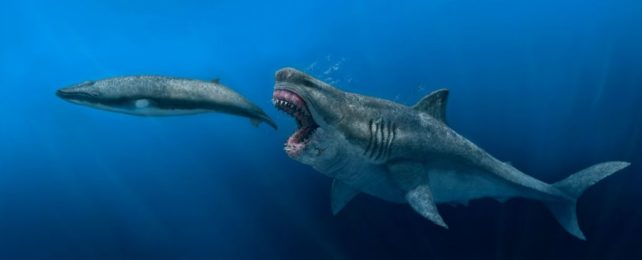The fearsome megalodon (Otodus megalodon) was a giant shark that once ruled the world's oceans, millions of years ago. Fearsome reputation aside, the famous predator left very little trace of its existence.
New research on an exceptionally well-preserved fossil has now given us the first 3D model of the extinct fish, one that tells us it could cruise at speeds faster than any shark in the ocean today.
Moreover, it was so large, scientists have found, that it could devour in just five bites whole prey the size of today's top predators: the large, 8-meter orcas that terrorize our most feared sharks today, the great white shark.
In fact, megalodon could easily have swallowed a white shark whole.
These findings suggest that megalodon was the most badass of the badass in prehistory… and, more importantly, they could give us a better idea of the role it played in the ocean ecosystems it dominated.
"Together, our results suggest that O. megalodon played an important ecological role as a transoceanic superpredator," writes a team of researchers led by paleobiologist Jack Cooper of Swansea University in the UK in their paper.
"Hence, its extinction likely had large impacts on global nutrient transfer and trophic food webs."
Piecing together megalodon from the fossil record has been something of an ongoing puzzle. It appeared on the scene about 23 million years ago and went extinct about 3.6 million years ago, for reasons unknown.
We only know of it, and can estimate its colossal size, based on those parts of it sturdy enough to survive the rigors of time – mostly teeth, up to the size of a human hand.
But teeth are not the only parts of a shark that can fossilize. The denser parts of its cartilaginous skeleton – in particular, its vertebrae – can, in the right conditions, also be preserved. In the 1860s, we discovered something amazing: an exceptionally well preserved, largely intact megalodon spine.
"Shark teeth are common fossils because of their hard composition which allows them to remain well preserved," Cooper says.
"However, their skeletons are made of cartilage, so they rarely fossilize. The megalodon vertebral column from the Royal Belgian Institute of Natural Sciences is therefore a one-of-a-kind fossil."
Now, sharks can come in a variety of shapes and sizes. Megalodon is thought to be pretty similar to white sharks (Carcharodon carcharias), even though the two species don't belong to the same shark family.
The fact of the matter is that we don't entirely know what megalodon looked like… but, using this spinal column as a basis, Cooper and his team have constructed what they believe is the most accurate megalodon model to date.
They started with measurements and scans of every single one of the vertebrae in the column. These scans formed the basis of a reconstruction of the entire megalodon spine.
Next, a mouth full of chompers was added, from a scan of megalodon teeth in the US. Finally, a 3D scan of a white shark from South Africa was used to fill in the body around the reconstructed spine and jaw.
"Weight is one of the most important traits of any animal," says evolutionary biomechanic John Hutchinson of the Royal Veterinary College in the UK.
"For extinct animals we can estimate the body mass with modern 3D digital modeling methods and then establish the relationship between mass and other biological properties such as speed and energy usage."
We know that megalodon was wide-ranging; its remains have been found at every continent, with the exception of Antarctica, suggesting that the shark really did rule the global ocean. The team's research shows how that may have been the case.
Megalodon's cruising speed, the team found, was over 5 kilometers (3.1) per hour, compared to 3 kilometers per hour for white sharks. The Belgian megalodon, the one whose spine formed the backbone of the model, was likely around 16 meters (52.5 feet) in length; other vertebrae suggest it could grow up to 20 meters long.
The Belgian megalodon's mouth would have been able to open 1.8 meters, based on the team's model, and it had a stomach capacity of around 9.6 cubic meters. From these metrics, the team inferred that a prey animal around 8 meters in length – the size of an adult orca – could be entirely consumed by megalodon in just five bites.
The caloric load of such a meal would be enough to sustain megalodon for two months as it swam Earth's oceans. This is similar to white sharks, which can go a month or two without eating if they get a big enough meal.
This means that the disappearance of megalodon from Earth's oceans may have changed undersea ecology more significantly that we realized.
"These results suggest that this giant shark was a trans-oceanic super-apex predator," says paleobiologist Catalina Pimiento of the University of Zurich in Switzerland.
"The extinction of this iconic giant shark likely impacted global nutrient transport and released large cetaceans from a strong predatory pressure."
The research has been published in Science Advances.
